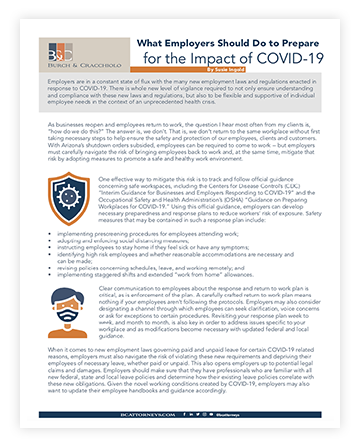 by Susie Ingold
by Susie Ingold
Employers are in a constant state of flux with the many new employment laws and regulations enacted in response to COVID-19. There is whole new level of vigilance required to not only ensure understanding and compliance with these new laws and regulations, but also to be flexible and supportive of individual employee needs in the context of an unprecedented health crisis.
As businesses reopen and employees return to work, the question I hear most often from my clients is, “how do we do this?” The answer is, we don’t. That is, we don’t return to the same workplace without first taking necessary steps to help ensure the safety and protection of our employees, clients and customers. With Arizona’s shutdown orders subsided, employees can be required to come to work -- but employers must carefully navigate the risk of bringing employees back to work and, at the same time, mitigate that risk by adopting measures to promote a safe and healthy work environment.
One effective way to mitigate this risk is to track and follow official guidance concerning safe workspaces, including the Centers for Disease Control’s (CDC) “Interim Guidance for Businesses and Employers Responding to COVID-19” and the Occupational Safety and Health Administration’s (OSHA) “Guidance on Preparing Workplaces for COVID-19.” Using this official guidance, employers can develop necessary preparedness and response plans to reduce workers’ risk of exposure. Safety measures that may be contained in such a response plan include:
- implementing prescreening procedures for employees attending work;
- adopting and enforcing social distancing measures;
- instructing employees to stay home if they feel sick or have any symptoms;
- identifying high risk employees and whether reasonable accommodations are necessary and can be made;
- revising policies concerning schedules, leave, and working remotely; and
- implementing staggered shifts and extended “work from home” allowances.
 Clear communication to employees about the response and return to work plan is critical, as is enforcement of the plan. A carefully crafted return to work plan means nothing if your employees aren’t following the protocols. Employers may also consider designating a channel through which employees can seek clarification, voice concerns or ask for exceptions to certain procedures. Revisiting your response plan week to week, and month to month, is also key in order to address issues specific to your workplace and as modifications become necessary with updated federal and local guidance.
Clear communication to employees about the response and return to work plan is critical, as is enforcement of the plan. A carefully crafted return to work plan means nothing if your employees aren’t following the protocols. Employers may also consider designating a channel through which employees can seek clarification, voice concerns or ask for exceptions to certain procedures. Revisiting your response plan week to week, and month to month, is also key in order to address issues specific to your workplace and as modifications become necessary with updated federal and local guidance.
When it comes to new employment laws governing paid and unpaid leave for certain COVID-19 related reasons, employers must also navigate the risk of violating these new requirements and depriving their employees of necessary leave, whether paid or unpaid. This also opens employers up to potential legal claims and damages. Employers should make sure that they have professionals who are familiar with all new federal, state and local leave policies and determine how their existing leave policies correlate with these new obligations. Given the novel working conditions created by COVID-19, employers may also want to update their employee handbooks and guidance accordingly.
by Susie Ingold
